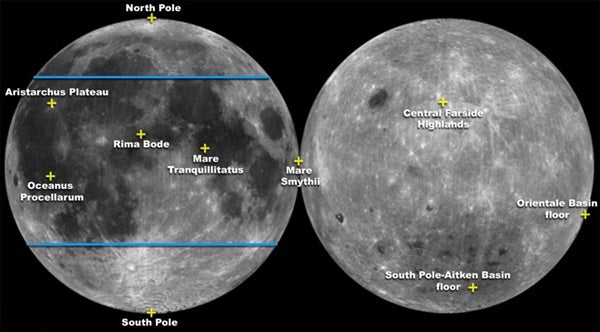“There were polar sites, there were equatorial sites, there were Apollo revisits, and there were farside sites,” Connolly says. “We wanted a system — both Crew Exploration Vehicle [CEV] and lander — that could get to any point on the lunar surface and return at any time.” The group used these sites as test cases to see how the new CEV and lunar-lander designs fared. “We wanted to make sure we had a system that performed as advertised.”
All Soviet and U.S. unmanned probes landed within 40° of the Moon’s equator on the side facing Earth. The manned Apollo landings spanned a more limited range, never straying more than 26° from the nearside lunar equator. But the ESAS plan tackles the entire lunar surface.
Sites were chosen both for their scientific value and for the likelihood that they hold resources astronauts could use to produce fuel, water, and oxygen. “We tried not to favor the north or the south pole. The south pole is perhaps more interesting scientifically, but both poles are equally interesting from a resources standpoint,” Connolly explains.
“The south pole seems to be the place where the resource people and the lunar-science people agree most,” Connolly says. “From the resource point of view, you have the presence of … water ice or other hydrogen-bearing molecules. From the science side, you have … the polar environment, but you’re also on the edge of the South Pole-Aitken Basin, so you have that geology, and you have the southern celestial hemisphere for optical astronomy.”
One site on the lunar farside is located in the floor of the South Pole-Aitken Basin, the Moon’s biggest impact structure. Planetary scientists believe the impact created an enormous sheet of molten rock, and the site they selected is right on the basin floor. The farside location would be an ideal spot for pursuing radio astronomy because the Moon’s bulk would block radio noise from Earth.
“Aristarchus has long been an area of interest to scientists,” Connolly notes. The region’s appeal lies in its diverse terrain, a coating of materials from the nearby Imbrium Basin materials, and evidence of past volcanic activity. “There’s a lot going on there.” The Aristarchus region also has a high titanium content, which means it likely contains chemicals from which oxygen can be extracted more easily than in other areas.
Other appealing landing sites include Rima Bode, another feature related to volcanism, and the central farside highlands, where scientists think they can find some of the Moon’s primordial crust. Oceanus Procellarum, which is covered with young mare material, is a good place to look if you want to calibrate the flux of impacting comets and asteroids. Mare Smythii and the giant multiring basin of Mare Orientale are relatively young features — and difficult to observe from Earth because they lie on the Moon’s limb.
“Water found anywhere in the solar system is like gold,” Connolly says. NASA’s Lunar Reconnaissance Orbiter, now slated to fly in 2008, will look for evidence of lunar water. “There’s no direct way to measure water from orbit,” notes Connolly, so plans call for a follow-up robotic lunar lander to explore the most promising site.
If all goes well, astronauts will follow as early as 2018.










